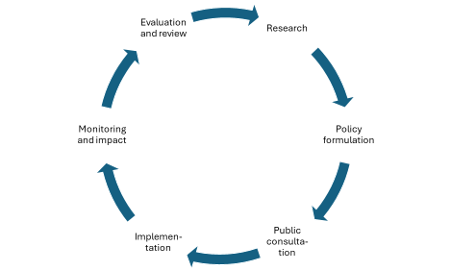
The open access books policy life cycle refers to a six-stage life cycle put forward by the PALOMERA project as a means to support the initial formulation and iteration of open access book policies regardless of which stage the policy is in the life cycle.
When considering a new open access books policy, a project plan should be created, which includes all aspects of the life cycle from initial research and policy launch to monitoring and evaluation. For example, it is important that, at the policy formulation stage, the creators of the policy understand how individual aspects of the policy will be monitored and how success will be measured. The length of time covered by the life cycle will vary according to national and organisational contexts but it is likely to cover a period of five to ten years, especially when including the first three ‘pre-launch’ stages.
1. Research
The first stage of the open access books policy life cycle refers to the research that policymakers need to undertake to understand what their policy will cover and how it fits in the wider landscape. Funders may want to consult with other regional, national and international policies to gain a greater understanding of the policy landscape. In order to do this, funders may want to use the PALOMERA Knowledge Base, a collection of documents including reports, policies, survey results and statistics that are relevant to open access policies regarding books in the European Research Area. Stakeholder analysis should also be conducted at this stage of the life cycle. For example, who should be involved (libraries, research funding organisations, research performing organisations, societies, publishers, researchers) and what is their current position about open access books.
2. Policy formulation
This stage of the life cycle describes the initial formulation of the open access books policy after initial research and contextualisation has been conducted. During this stage, funders may wish to consult with other funders regarding lessons learned, etc., which, for example, could be done through the PALOMERA Funder Forum. This process is likely to involve internal consultation as well as initial stakeholder consultation. Therefore, stages two and three are likely to be iterative processes.
3. Public consultation
This stage of the life cycle refers specifically to the public consultation that should be undertaken to ensure that appropriate stakeholders have had the opportunity to feed into the proposed open access books policy. This could form part of a wider open access policy consultation. At this point, a near final draft of the policy is required, so internal and initial stakeholder consultation needs to have taken place. However, this will be an iterative process and an appropriate amount of time should be given for stakeholders to provide feedback on the proposed policy, which may take as long as six months. This stage of the life cycle should also include the analysis of the consultation responses.
The PALOMERA Funder Forum may also be a useful tool during stages two and three of the life cycle.
4. Implementation
Implementation describes the whole process from the announcement of the open access books policy to the launch of the policy itself. This process is largely about preparation within the national context of the policy. The date when the policy will come into effect should be announced well in advance (at least 12 months) and include information about in-scope and out-of-scope works in terms of date of submission of manuscript or date of publisher-author contract/date of publication. During this stage, a variety of stakeholder engagement activities should take place alongside the promotion of detailed guidance about compliance with the policy. In addition, if funding is to be made available as part of the policy, appropriate internal and external workflows will be required to ensure effective means to apply for and receive funding. Regarding compliance, a detailed plan will be required to enable monitoring and impact to start at policy launch.
5. Monitoring and impact
As stated at the beginning of this article, methods of monitoring the policy and its impact need to be planned from the beginning. Once the policy is launched, these methods need to be in place to ensure the smooth running of the policy. There are two important areas that should be distinguished. The monitoring of compliance against the policy and the monitoring of impact, usage statistics for example. Monitoring of the policy will largely depend on the attributes of the policy and the national context, as well as on the availability of appropriate data. Engagement with open infrastructure providers will be required in order to run this and the next stage effectively, and to keep the data FAIR where possible. FAIR data are data which meet principles of findability, accessibility, interoperability and reusability (FAIR).
6. Evaluation and review
The final stage of the open access books policy life cycle is conducting a formal review of the policy after a given amount of time. All policies should have a review date built into the life cycle to ensure to what extent the policy meets its objectives. This could be a full review, which will feed into stage one of the process and start the open access books policy life cycle again for a new version of the policy. This is an opportunity to review the landscape as well as the policy itself. For example, it is widely accepted that aspects of the open access books landscape are less mature than others, such as metadata quality. A review of the existing landscape may provide insight on where a new policy could be tightened or improved.

This article is made available under a Creative Commons Attribution 4.0 International License.
